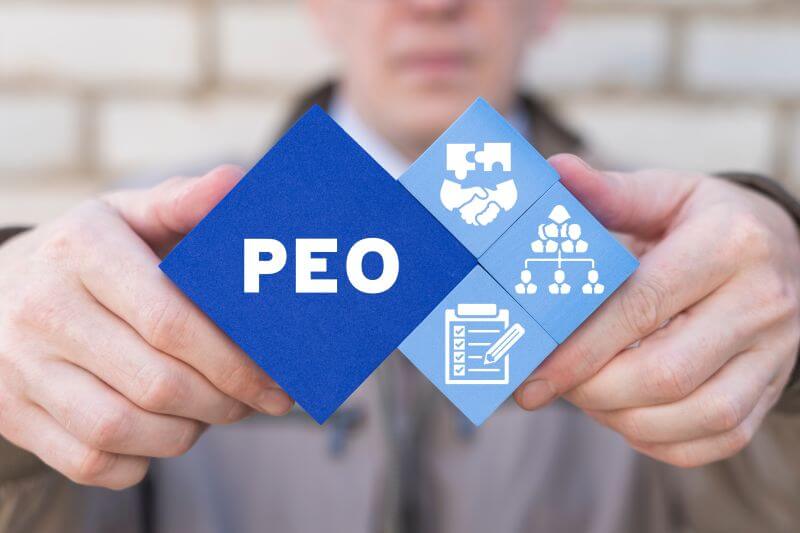PEO vs Staffing Agency: Key Differences in Services and Relationships

December 27, 2023
Many companies mistakenly assume a professional employer organization (PEO) performs the same services as a staffing agency. However, when comparing PEO vs staffing agencies, their capabilities, relationships, and cost models differ considerably.

As key players in today’s human resources ecosystem, both professional employer organizations (PEOs) and staffing agencies facilitate critical talent needs for businesses. While outsourcing certain HR functions has become vital for organizations lacking internal infrastructure, it’s important to understand the distinction between PEO vs staffing agency.
Defining a professional employer organization (PEO)
A professional employer organization (PEO) enters into a contractual co-employment agreement with client companies to provide integrated human resources administration. Under the co-employment model, the PEO formally shares critical employer obligations and risks. This empowers the PEO to offer a comprehensive suite of HR services encompassing payroll, benefits, compliance, workers’ compensation, and more on an ongoing basis. The client organization continues to direct its workforce’s day-to-day jobs, projects, and production while benefiting from the PEO’s employer infrastructure.
Core HR responsibilities managed by PEO services include:
- Payroll processing and reporting
- Health insurance plans, retirement accounts, and other benefits enrollment and administration
- Compliance with employment laws and labor regulations
- Risk management for safety, unemployment claims, and other liability exposures
Unlike staffing agencies, PEOs focus on providing complete HR facilitation rather than temporary talent fulfillment. This frees client companies to concentrate on operating their business.

Understanding staffing agencies
Staffing agencies specialize in recruiting, vetting, and supplying contract workers or permanent job candidates to client organizations on a temporary or project-specific basis. They do not enter formal co-employment partnerships.
Key services provided by staffing agencies encompass:
- Posting jobs and sourcing qualified applicants
- Screening candidates with interviews, skills testing, and reference checks
- Presenting a shortlist of suitable talent aligned to the client’s requirements
- Arranging placements for temporary, temp-to-hire, or permanent hiring scenarios
While staffing agencies facilitate crucial talent acquisition, the client company retains full employer status. Client organizations manage all employment-related obligations for compliance, payroll, benefits, supervision, and termination.
Key differences between PEO and Staffing Agency
When considering outsourcing certain HR functions, companies often look into PEO vs staffing agencies. Both provide valuable services but have important distinctions in their relationships with client organizations. Understanding the key differences between PEO and staffing agencies can help business leaders choose the model that fits their needs.
To compare PEOs and staffing agencies, here are some of the main areas where their services and relationships diverge:
| Feature | PEO | Staffing Agency |
| Co-employment vs standard employment | Has a co-employment relationship with the client company. Becomes the employer of record for tax purposes. | Does not have co-employment; the client manages employees. Maintains an arm’s length relationship, with client companies retaining full employer status. |
| Scope of HR services | Provides a full suite of HR services (payroll, benefits, compliance). Offers integrated payroll, benefits, HR systems, compliance assistance. | Focus mainly on recruiting and talent placement. While staffing agencies source and screen talent, they do not provide an ongoing HR platform. |
| Liability and risk | Assume many employer liabilities and risks. With co-employment status, PEOs absorb substantial employer obligations and exposure. | Limits liability to the hiring/onboarding process. Staffing agencies have circumscribed legal risks centered on candidate vetting and placement. |
| Employee management | Lets the client company manage employees day-to-day. Handles background HR administration while clients directly supervise workers. | Can fully manage employees on behalf of a client. Staffing agencies can supply contract talent fully under their hierarchy. |
| Cost structure | Charges flat fee or percentage of payroll. Ongoing PEO fees reflect transferring core employer costs. | Charges per hire or placement fees. Staffing bills episodically to fill talent needs. |
| Relationship | Has an ongoing, long-term partnership with the client. PEOs structure multiyear relationships around consistent HR support. | Arrangements can be temporary or project-based. Staffing addresses fluctuating or interim hiring needs. |

Practical considerations in choosing between a PEO and a Staffing Agency
Evaluating the unique capabilities of professional employer organization and staffing agencies, including their cost structures, allows organizations to align services to their priorities. Companies with limited in-house HR experience often benefit from a PEO’s holistic and compliance-centric approach. Those seeking flexibility to rapidly scale teams on demand may leverage staffing agencies more regularly.
Conducting in-depth due diligence allows clients to select providers with reputations for quality service and consultative support. Whether choosing ongoing HR assistance via a PEO or targeted staffing, the ultimate decision comes down to which model best promotes an organization’s growth, risk mitigation, and human capital strategy.
In reviewing the divergence across PEO and staffing agency services, what decision makers must determine is whether their priority is strategic HR administration or tactical talent acquisition. Evaluating needs for integrated payroll, compliance, and benefits under a co-employment partnership versus flexible staffing assistance allows organizations to select the partner and framework that best aligns to support their human capital and growth objectives.




